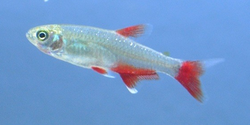Bloodfin Tetra

This fish may not be as appealing as say, a Neon Tetra, but don't be fooled this fish has it perks. It is an active, hardy and prosperous fish that can live up to 10 years in captivity! They are also extremely active and can be quite entertaining to watch. This fish is ideal for beginners who are just stepping into the world of fish. They are a peaceful schooling fish like all tetra and should be in a group of 5 or more. Bloodfin Tetras are not at all aggressive and can be kept with other fish species of a similar size. To simulate their natural environment it would be nice to keep these fish with aquatic plants such as Java Fern or Java Moss, however, that is not compulsory.
Profile
Difficulty: Easy
Origin: South America
Size: 5.5cm (2 inches)
Tanks Size: 60 cm (24 inches) or 40L (10 gallon)
Temp: 18 – 28°C (64.5 – 82.5°F)
pH: 6-8
Lifespan: 10 years
Hardness: 2-30dH
Food: flakes, brine shrimp, crustaceans, worms, live/frozen food, bloodworms
Breeding
- easy to breed in captivity (can double their population in 15 months in native habitat)
- keep broad leaf aquatic plants for the Bloodfin to lay and fertilise their eggs on.
- Bloodfin spawn without manipulation on the aquarist (so beginners can breed them easily)
- eggs are not adhesive and are usually laid on broad leaf plants (Java Fern would come in handy)
- spawning behavior involves the mating fish to jump out of the water, releasing eggs as they do so (it is therefore critical to have a lid on an aquarium with Bloodfin)
- they usually produce between 300 - 500 eggs (egg-scattering species) and will not care for their young and in fact will eat them if given the chance
- to increase the survival of the fry the aquarium should have lots of hiding places (Java Moss makes a good hiding place for fry)
- fanatic breeders even cover the substrate with marbles so that the eggs fall through making them inaccessible by the parents. Some use a separate aquarium dedicated to breeding where they remove the parents after spawning to decrease the mortality rate of the fry.
Sexing: Males are more colorful and have a small hook on the anal fin. Females are more dull and plumper.
Profile
Difficulty: Easy
Origin: South America
Size: 5.5cm (2 inches)
Tanks Size: 60 cm (24 inches) or 40L (10 gallon)
Temp: 18 – 28°C (64.5 – 82.5°F)
pH: 6-8
Lifespan: 10 years
Hardness: 2-30dH
Food: flakes, brine shrimp, crustaceans, worms, live/frozen food, bloodworms
Breeding
- easy to breed in captivity (can double their population in 15 months in native habitat)
- keep broad leaf aquatic plants for the Bloodfin to lay and fertilise their eggs on.
- Bloodfin spawn without manipulation on the aquarist (so beginners can breed them easily)
- eggs are not adhesive and are usually laid on broad leaf plants (Java Fern would come in handy)
- spawning behavior involves the mating fish to jump out of the water, releasing eggs as they do so (it is therefore critical to have a lid on an aquarium with Bloodfin)
- they usually produce between 300 - 500 eggs (egg-scattering species) and will not care for their young and in fact will eat them if given the chance
- to increase the survival of the fry the aquarium should have lots of hiding places (Java Moss makes a good hiding place for fry)
- fanatic breeders even cover the substrate with marbles so that the eggs fall through making them inaccessible by the parents. Some use a separate aquarium dedicated to breeding where they remove the parents after spawning to decrease the mortality rate of the fry.
Sexing: Males are more colorful and have a small hook on the anal fin. Females are more dull and plumper.

